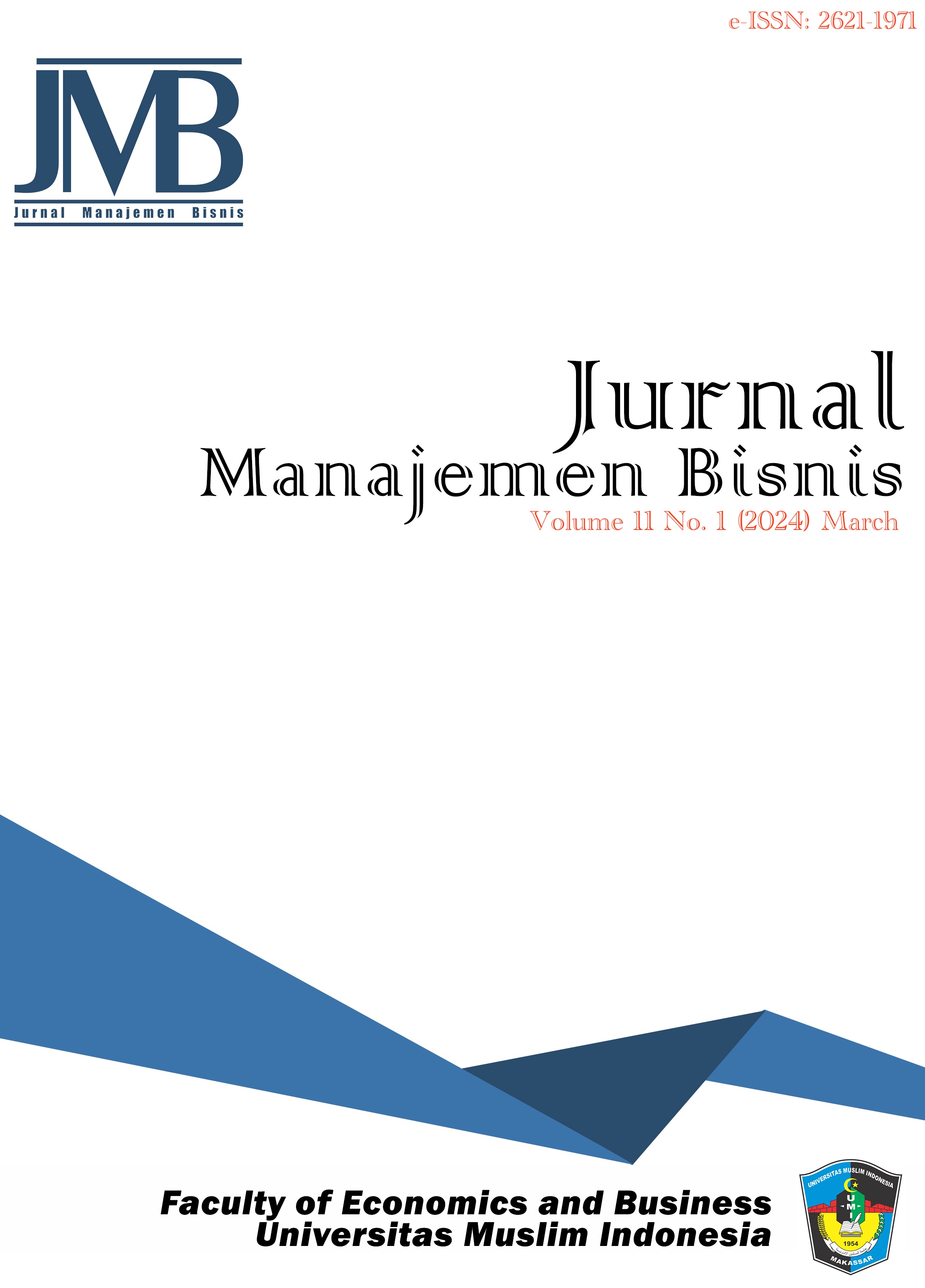The Effect of Return on Assets Ratio, Debt to Equity Ratio and Sales Growth on Tax Avoidance
DOI:
https://doi.org/10.33096/jmb.v11i2.922Keywords:
Return on Assets Ratio, Debt to Equity Ratio, Sales Growth, Tax Avoidance, Cash Effective Tax RatesAbstract
This study aims to determine the role of Return On Assets Ratio (ROA), Debt To Equity Ratio (DER), and Sales Growth on Tax Avoidance, with a research focus on the Energy sector listed on the Indonesia Stock Exchange for the 2020-2022 period. A sample of 45 companies was used, taken using the purposive sampling technique. The data analysis technique used is quantitative analysis. This analysis shows that ROA and DER have a significant effect on Tax Avoidance, while sales growth has no effect. The data management procedure was carried out with the help of IBM SPSS 26.
Downloads
References
Astari, N. P. N., Mendra, N. P. Y., & Adiyadnya, M. S. P. (2019). The Effect of Sales Growth, Profitability, Leverage, and Company Size on Tax Avoidance. Collection of Accounting Student Research Results (KHARISMA), 1(1).
Aramana, D. (2021). The Effect of Liquidity, Assets, and Sales Profitability on the Capital Structure of the Consumer Goods Industry on the Indonesia Stock Exchange, 621-637.
Indonesia Stock Exchange. 2023. Energy Sector Financial Report Data in www.idx.co.id (accessed on October 8, 2023).
Dyreng, Scott D. Hanlon Michelle & Maydew Edward L. (2010). re Family Firms more Tax Aggresive than Non-Family Firms? Journal of Financial Economics.
Dewinta, I. A. R., & Setiawan, P. E. (2016). The influence of company size, company age, profitability, leverage, and sales growth on tax avoidance. E-Journal of Accounting, Udayana University, 14(3), 1584-1613.
Dyreng, Scott D. Hanlon Michelle & Maydew Edward L. (2010). The Effect of Executives on Corporate Tax Avoidance. The Accounting Review, 1163-1189.
Fahruzzi, Andika., Dedi Hariyanto, Dedi., & Safitri Heni. (2016). The Effect of Net Profit Margin, Return on Asset, Return on Equity, and Earning Per Share on Stock Prices in Manufacturing Companies in the Consumer Goods Industry Sector Listed on the Indonesia Stock Exchange. Journal of Productivity, 39.
Fatimah. (2021). The Impact of Indonesia's Tax Avoidance is Estimated at Rp. 60.7 Trillion. Taken from Pajakku: https://www.pajakku.com/read/5fbf28b52ef363407e21ea80/Dampak-Penghindaran-Pajak-Indonesia-Diperkirakan-Rugi-Rp-687-TriliunDiakses on October 8, 2023, from Pajakku
Fajarwati, P. A. N., & Ramadhanti, W. (2021). The Effect of Accounting Information (ROA, Leverage, Sales Growth, Capital Intensity and Company Size) and Company Age on Tax Avoidance. Journal of Investment, 7(1), 1-15.
Ghozali, I. (2016). Multivariate analysis application with IBM SPSS 23 program. Semarang: Diponegoro University Press. . (2017). Application of multivariate analysis with IBM SPSS 23 program. Semarang: Diponegoro University Press.
Hery. (2015). Analysis of Financial Statements. Yogyakarta: CAPS.
Handayani, R. (2018)). The Effect of Return on Assets (ROA), Leverage and Company Size on Tax Avoidance in Banking Companies Listed on the Banking Company. Maranatha Accounting Journal, 10(1), 72–84.
Harahap, Sofyan Syafri. (2015). Critical Analysis of Financial Statements. PT. RajaGrafindo Persada, Jakarta.
Irawati, W., Akbar, Z., Wulandari, R., & Barli, H. (2020). Analysis of profitability, leverage, sales growth and family ownership against tax avoidance. JAK (Journal of Accounting) Scientific Review of Accounting, 7(2), 190-199.
Cashmere. (2010). Analysis of Financial Statements. Third Printing. Jakarta: Raja Grafindo Persada. (2018). Financial Statement Analysis. PT. King Grafindo Persada.
Ministry of Finance. (2021). State revenue and expenditure budget 2021. Ministry of Finance Directorate, 1–48.
Kurniasih, T., & Sari, M. M. R. (2013). The effect of Return on Assets, leverage, corporate governance, company size and fiscal loss compensation on tax avoidance. Economic Studies Bulletin 18(1), 58–66.
Nabilla, S. S., & ZulFikri, I. (2018, October). The Effect of Corporate Risk, Leverage (Debt To Equity Ratio) and Sales Growth on Tax Avoidance (Empirical Study on Manufacturing Companies in the Food & Beverage Subsector Listed on the IDX in 2014-2017). In Proceedings of the National Seminar of Scholars (pp. 1179-1182).
Pohan, C. A. (2016). Tax Management, Tax and Business Planning Strategies. Revised Edition. Jakarta: PT Gramedia Jakarta.
Padmayanti, N. P. E. W., Suryandari, N. N. A., & Munidewi, I. B. (2019). The Effect of Financial Performance on the Value of Companies with Independent Board of Commissioners as a Moderating Variable in Manufacturing Companies Listed on the Indonesia Stock Exchange. Winner: Journal of Accounting Research, 9(1).
Pri Anggun Novria Fajarwati, Wita Ramadhanti. (2021). THE EFFECT OF ACCOUNTING INFORMATION (ROA, LEVERAGE, SALES GROWTH, CAPITAL INTENSITY AND COMPANY SIZE) AND COMPANY AGE ON TAX AVOIDANCE. Master of Accounting Study Program, Faculty of Economics and Business, Jenderal Soedirman University, 1.
Sampurno, F. P. L. (2023). The role of institutional ownership as a moderating variable in the influence of ROA, CR, and DER on tax avoidance. COSTING: Journal of Economic, Business and Accounting, 7(1), 1166-1177.
Sugiyono. (2013). Quantitative, Qualitative and R&D Research Methods Bandung: Alfabeta.
Sujaweni, V. Wiratna. (2014). Research Methods. Yogyakarta: Pustaka Baru Press.
Xynas, Lidia. (2011). Tax Planning, Avoidance and Evasion in australia 1970-2010. . The Regulatory Responses and Taxpayer Compliance, Revenue Law Journal, 20-1.
Zul Akbar, Wiwit Irawati, Rosita Wulandari, Harry Barli. (2020). ANALYSIS OF PROFITABILITY, LEVERAGE, AND SALES GROWTH. Journal of Accounting, 1
Downloads
Published
Issue
Section
License
Copyright (c) 2024 Jurnal Manajemen Bisnis

This work is licensed under a Creative Commons Attribution 4.0 International License.






